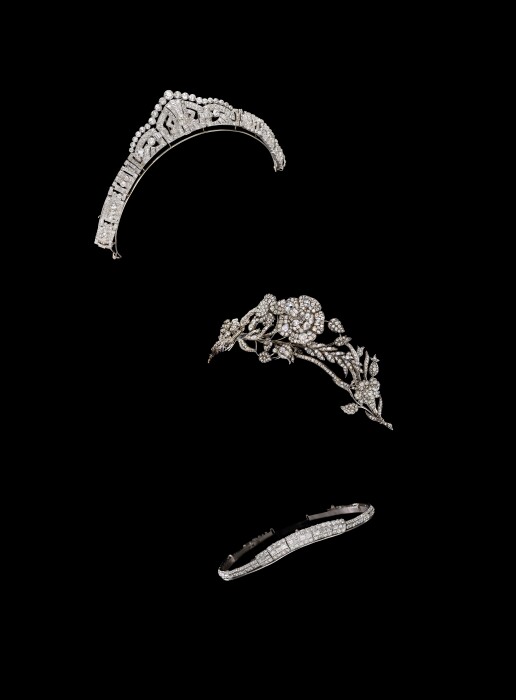Tiaras of the Eras
A universal symbol of poise, elegance and sophistication, the tiara has long been an inspiration for fascination worn by the most powerful and beautiful women in history.
Stemming from the ancient world when victors were crowned with laurel wreaths, and newlyweds with myrtle, sacred to Aphrodite, to festive, celebratory daisy chains, gold wreaths were the evolution of endless possibilities made possible through the craft of goldsmiths. Gold wreaths established an important role in Ancient Greece, often worn as a tribute to Zeus, symbolising power and omniscience soon lending its inspiration to the future of tiaras to come.
Tiaras are often admired for their delicate nature and craftsmanship holding a sacred position in the world of jewellery. Pieces so intricately engineered to balance atop beautifully set hair paying tribute to the lavish history and symbolism it holds. Pageants, masquerades and costume balls surround the idea of extravagance, a crucial participant of each eccentric event was the part in which headdresses played.
At the turn of the century, there was hardly a goldsmith who failed to recognize the importance of tiaras, often the subject of their prized collections. Whilst International Exhibitions and Paris Salons presented the platform for jewellers to impress, it soon became apparent that no other jewel would outshine the potential of a tiara.
Today, modern monarchies wear their tiaras which are rich in family history and telling of their heritage whilst modern brides often bring a regal touch to their bridal looks elevated with a hint of antiquity. Lots 1654, 1655 and 1656 demonstrate the styles of three different eras, unique in their own ways. Versatility is also a virtue of longstanding craftsmanship. Lot 1654 can be detached into three openwork brooches whilst Lot 1656 converts beautifully into a stylish necklace by Cartier lending the wearability of these masterworks into everyday life.

- DIAMOND TIARA / CLIP BROOCHES / BRACELET, POSSIBLY GARRARD & CO.| 鑽石冠冕 / 胸針 / 手鏈, Possibly Garrard & Co.
- DIAMOND TIARA, POSSIBLY CARRINGTON & CO., LATE 19TH CENTURY | 鑽石冠冕 , Possibly Carrington & Co., 19 世紀晚期
- CARTIER | DIAMOND TIARA | 卡地亞 | 鑽石冠冕
冠冕時代
回顧歷史上的女王、皇后、公主、王妃,她們頭戴的金銀寶石皇冠不只是精緻貴重的配飾,更重要的是,皇冠代表着主人尊貴超凡的地位。
在古典時期,希臘人用月桂葉冠為勝利者加冕,讓新人戴上愛神阿芙洛狄蒂的聖花——香桃木花葉冠,又會在節慶時戴上用小雛菊串成的花環。古希臘金銀匠人參考了形形色色的花冠造型,打造出黃金頭冠,作為一份最尊榮貴重的禮物奉獻給全能的天神宙斯, 由此逐漸衍生出世俗王權的皇冠首飾。
珠寶首飾的世界五光十色,造型千變萬化,但若論尊貴特殊,非皇冠莫屬。在精心梳理的髮髻上,峨然立著一頂高貴的冠環,鑲滿耀目的寶石、精巧的鏤雕花紋、還有沉甸甸的貴金屬框架,這種瑰麗矚目的身份象徵物從古流傳至今,逐漸演變為選美大會、化妝舞會和晚會盛宴參加者的隆重行頭,襯托現代淑女名媛的俏麗紅顏。
二十世紀初,頭冠首飾在西方流行一時,幾乎所有珠寶匠都認為頭冠設計是匠藝生涯上的亮點。國際展覽和巴黎沙龍也少不免推波助瀾,紛紛為珠寶商和設計師提供場地展示作品。頭冠是那個繁華的黃金年代的身份象徵,彰顯主人富貴而優雅莊嚴的氣度。
如今所見,歐洲各國皇室女子所戴的皇冠皆是家傳重寶,昭示源遠流長的貴族血統。現代新娘也愛戴頭冠,為此生一回的婚宴盛裝添一份貴氣和古典美感。拍品1654、1655及1656 分別代表三個不同年代的風格。拍品1654 可分拆為三件鏤空別針;拍品1656頭冠可轉換成一條時尚精緻的卡地亞項鏈,如此自由隨場合、心情和打扮而變換的設計,可見匠心細膩。





